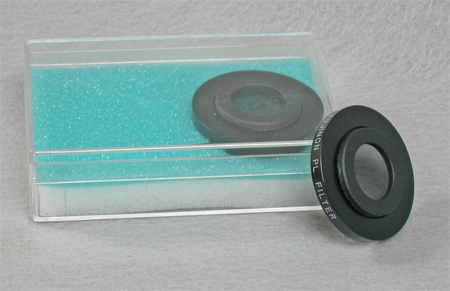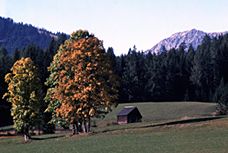Distribution
![]() Fujinon Index Page
Fujinon Index Page
![]() News
News ![]() Notes & Interesting Articles
Notes & Interesting Articles ![]() Pricing
Pricing ![]()

Fujinon Linear Polarizing Filter Set
 The Fujinon Linear Polarizing filter is one of the most valuable accessories that may be installed onto a binocular or telescope when used for terrestrial applications. Polarizing sun glasses are very popular among those who recreate or work outdoors since on sunny or overcast days and even on rainy days a polarizing element can greatly reduce the glare or light reflected off non metallic surfaces. The degree of the effect depends on the angle of the observer to the source and the surface, but the filter works to reduce glare off snow or water, on leaves in a forest, off feathers of a bird, the glare off windows or damp street surfaces. These add comfort and bring more clarity to the observing experience.
The Fujinon Linear Polarizing filter is one of the most valuable accessories that may be installed onto a binocular or telescope when used for terrestrial applications. Polarizing sun glasses are very popular among those who recreate or work outdoors since on sunny or overcast days and even on rainy days a polarizing element can greatly reduce the glare or light reflected off non metallic surfaces. The degree of the effect depends on the angle of the observer to the source and the surface, but the filter works to reduce glare off snow or water, on leaves in a forest, off feathers of a bird, the glare off windows or damp street surfaces. These add comfort and bring more clarity to the observing experience.
Sir David Brewster (1781-1868) is credited with the first explanation of the polarization phenomenon of light reflected at specific angles. He was a Scottish physicist and experimenter who also invented the kaleidoscope, made noteworthy improvements to the stereoscope. When natural or artificial light strikes a reflective surface at a certain angle (termed "Brewster's Angle"), then the light reflected from that surface is plane-polarized. Sir David Brewster demonstrated and explained there is a simple relationship between the incident angle of the light beam and the refractive index of the reflecting material.
Right: Fujinon Polarizing Filters. Set of two filters shown with provided plastic case (102,303 Bytes).
Sunlight and almost every other form of natural and artificial illumination produce light waves whose electric field vectors vibrate in all those planes that are perpendicular to the direction of propagation (coming from the source). When the electric field vectors are restricted to a single plane by some means of filtration of the beam, then the light is referred to as plane or linearly polarized with respect to the direction of propagation, and all waves vibrating in a single plane are termed plane parallel or plane-polarized. When light travels through a linear polarizing material only a selected vibration plane is passed by the polarizer, while the electric field vectors vibrating in all other orientations are blocked. Linearly polarized light transmitted through a polarizer can be either passed or absorbed by a second polarizer, depending upon the electric vector transmission azimuth orientation of the second polarizing material.
By eliminating the reflection of light off the water surface for example, depending on the transparency of the water it may be possible to see fish, reefs, etc. below. By eliminating the reflection of light off the tiny particles and water droplets suspended in the atmosphere, the polarizer also shows skies as more color saturated and slightly darker. This not only helps one to see more details, but it also reduces eye fatigue over longer observing sessions. The filter also acts as about a 2 stop neutral density filter with an adjustable degree of warming or cooling of the object in view, depending on the filters rotational orientation. For astronomical applications, the single polarization filter has few positive effects and needlessly attenuates light.
 Countryside scene image taken without Polarizing Filter |
 Countryside scene image taken with Polarizing Filter |
This Fujinon model is a Linear Polarizing filter as opposed to Circular; the other being a popular type of polarizing filter which is preferred for photography with TTL metering cameras.
The Polarizing Filter element installed into a cast and machined alloy bracket. It is compatible with several of the Fujinon binoculars sold by Company Seven. To install the filter simply unthread the binocular rubber eyecup with its metal frame, thread the filter into place over the eyepiece, then replace the rubber eyecup over the filter. Rotate the filters while looking through the binocular in order to obtain the best effect.
The Polarizing Filter may be left attached onto a binocular however, it does attenuate brightness so much so that those who plan to use the binocular in low light conditions or at night for the observation of fainter objects should remove the Polarizing Filters first.
Fujinon Polarizing Filter Specifications
| Filters Per Set | Two |
|---|---|
| Polarization | Linear |
| Weight (each) | 0.5 oz / 14 g |
| Diameter of Element | 17.95 mm (0.7 inches) |
| Diameter of Cell | 43.1 mm (1.7 inches) |
* Specifications are subject to change without notice.
Contents Copyright 1998-2006 Company Seven All Rights Reserved